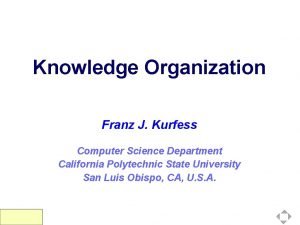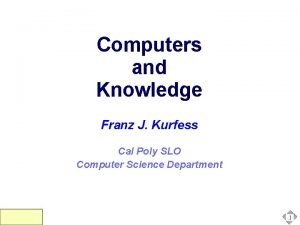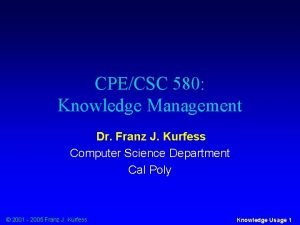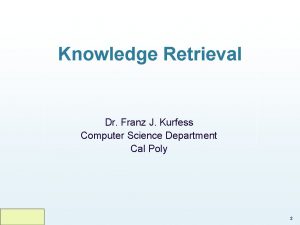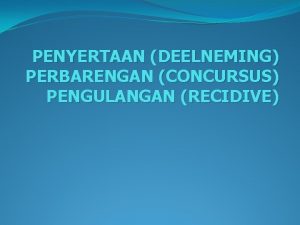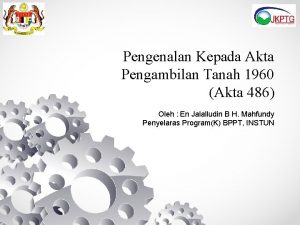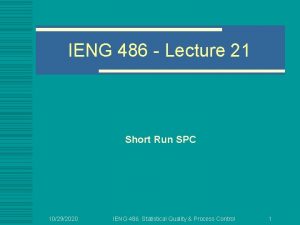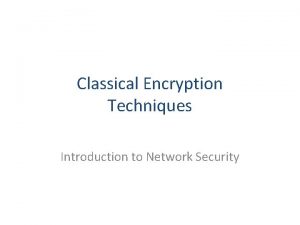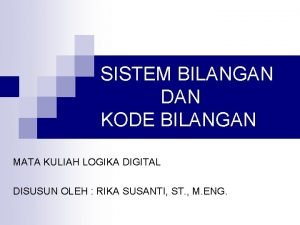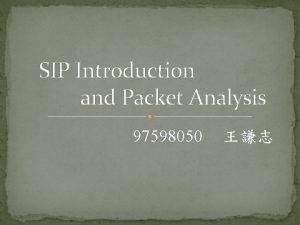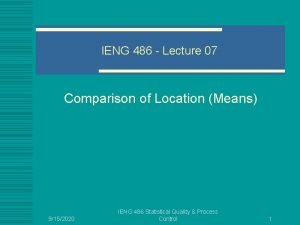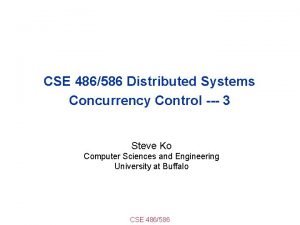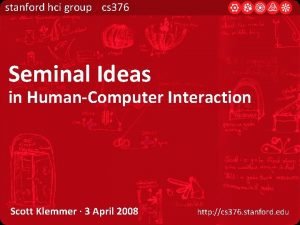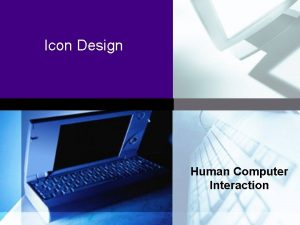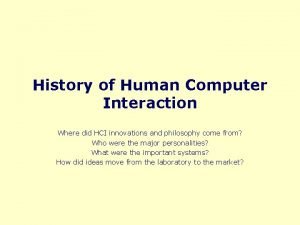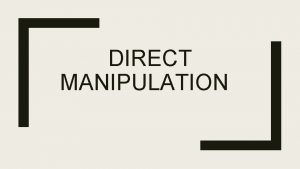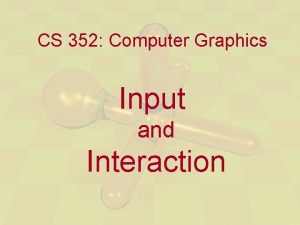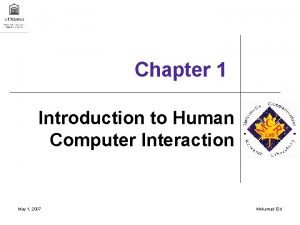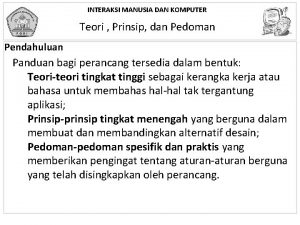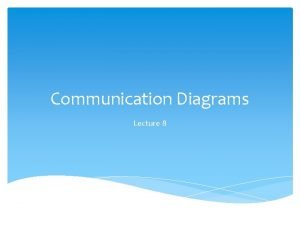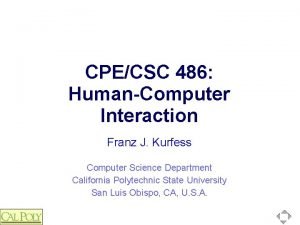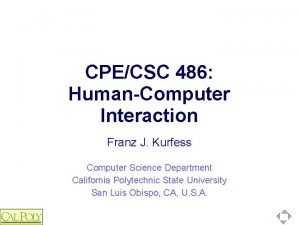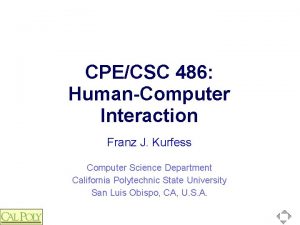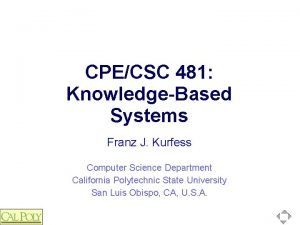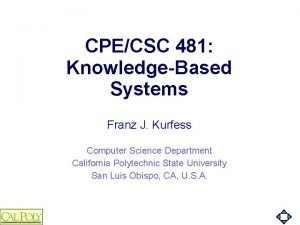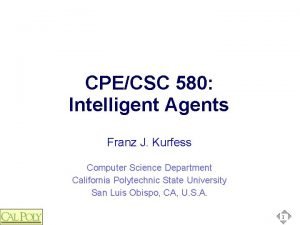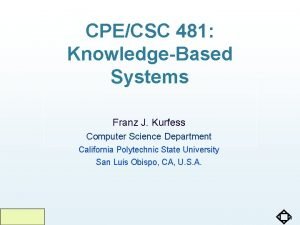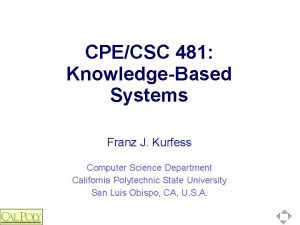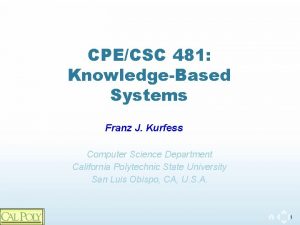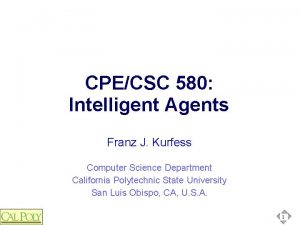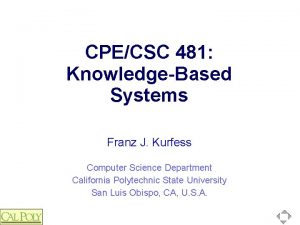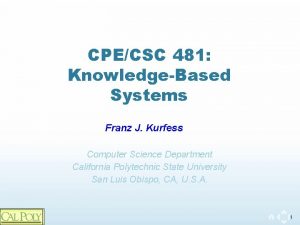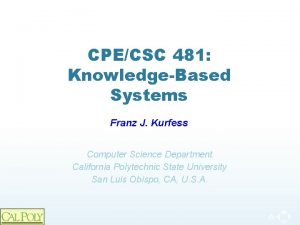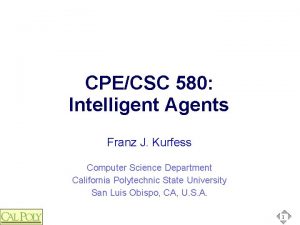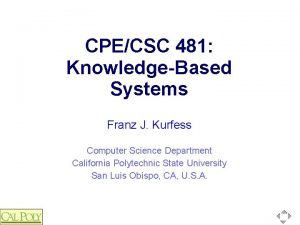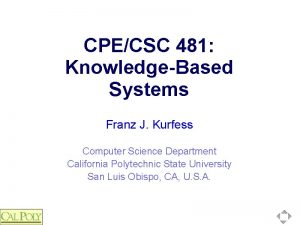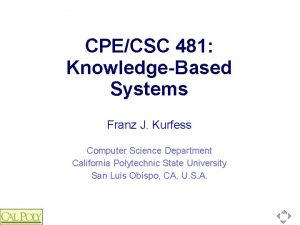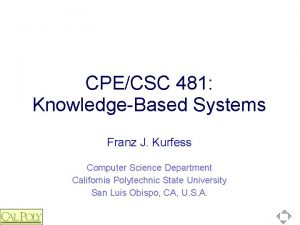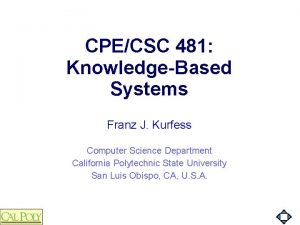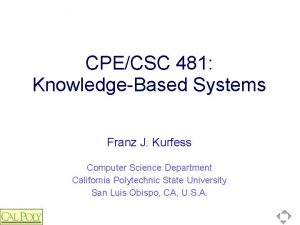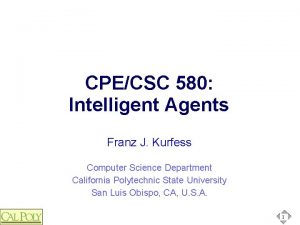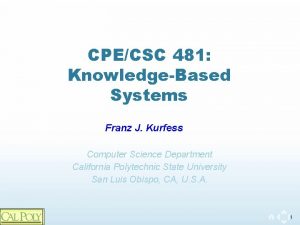CPECSC 486 HumanComputer Interaction Franz J Kurfess Computer




























![Additional Reading © Franz J. Kurfess [Mustillo] 37 Additional Reading © Franz J. Kurfess [Mustillo] 37](https://slidetodoc.com/presentation_image/006c2e0b0fc465eaf78479e23fff4852/image-29.jpg)


- Slides: 31

CPE/CSC 486: Human-Computer Interaction Franz J. Kurfess Computer Science Department California Polytechnic State University San Luis Obispo, CA, U. S. A.

Course Overview ❖ Introduction ❖ Cognitive Foundations ❖ Input-Output Devices ❖ Interaction Spaces ❖ Interaction Styles ❖ Interaction with Mobile Devices ❖ Speech-Based Interaction ❖ User Assistance © Franz J. Kurfess 3

Chapter Overview Interacting with Devices ❖ Agenda ❖ Motivation ❖ Objectives ❖ Basic Concepts v v ❖ Problem Space Interaction Information Transmission Channel Encoding Interaction Space Characteristics v v spatial aspects v dimensions v proximity temporal aspects © Franz J. Kurfess 4

Logistics ❖ ❖ Use of HCI Lab Facilities v Morae v reservations for exclusive use of the lab Open House: Fri, April 13 + Sat, April 14 v opportunity for usability evaluations and data collection v ❖ Loaner Devices Checkout v ❖ i. Pads, XBox + Kinect, PS 3 + Move, Qualcomm Android kits Assignments v ❖ Fri ~2: 30 - 4: 00 pm: new students, parents A 1 due today v project-related => TRAC Wiki v others => Poly. Learn Assignment Submission A 2 published (same as 484 - A 4) Research Activity v topic selected? v dissemination method discussed (paper, blog, video) Term Project v addition of students who enrolled late v contact and regular meetings with external customers © Franz J. Kurfess 5

Motivation ❖ the devices used for input and output determine the nature and capacity of information transferred between human and computer ❖ characteristics of the I/O devices influence user interface design to a large degree ❖ the choice of an inappropriate or inadequate design will diminish the performance of the task ❖ combinations of I/O devices can increase the usability of a system © Franz J. Kurfess 10

Objectives ❖ identify the main I/O devices used in computer systems ❖ know the important characteristics of these devices ❖ evaluate the suitability of I/O devices for particular purposes or tasks ❖ be able to select an appropriate combination of I/O devices for a specific task © Franz J. Kurfess 11

Basic Concepts Interaction Spaces v v Problem Space Interaction Information Transmission Channel Encoding 13

Problem Space ❖ “Interaction Space” in analogy to “Problem Space” v abstract space that captures possible interactions v v analogous to possible solutions in the problem space possibly represented as a graph v I’m not sure if this actually works. . . v may require a suitable abstraction v v interaction v v continuous => discrete? path through the interaction space interaction points v nodes in the graph spanning the interaction space © Franz J. Kurfess 14

Interaction ❖ sequence of communication activities between two entities v ❖ in this context: v human v computer requires communication channels v pairs of compatible actuators and sensors © Franz J. Kurfess 15

Information Transmission Channel ❖ connects a transmitter and a receiver ❖ transmits information v v possibly affected by noise limited by the channel capacity http: //en. wikipedia. org/wiki/Channel_(communications) http: //en. wikipedia. org/wiki/Channel_capacity © Franz J. Kurfess 16

Encoding ❖ mapping from a source alphabet to a target alphabet v decoding is the reverse operation © Franz J. Kurfess 17

Information Transmission Channels Diagram © Franz J. Kurfess 18

Example: Visual System © Franz J. Kurfess 19

Characteristics Interaction Spaces 20

Spatial Aspects ❖ ❖ dimensions v 1 D v 2. 5 D v 3 D proximity v direct contact v v close proximity v v within reach medium v v touch within transmission range far v beyond transmission range © Franz J. Kurfess 21

Temporal Aspects ❖ dimensions v 1 D v v 1. 5 D v ❖ linear nature of time signals as waves? persistence v v duration of signal availability v sender v receiver signal preservation v natural via remembering v technological via recording © Franz J. Kurfess 22

Signal Transmission ❖ encoding v ❖ transmission method v v ❖ text, icon, image, sound electromagnetic waves v light v sound direct contact transmission medium v natural v v air, water, solid material technology v wire, wireless © Franz J. Kurfess 23

Resilience ❖ capability to resist interference v noise v multiple signals attention v © Franz J. Kurfess 24

Navigation ❖ selection of relevant elements of the interaction space © Franz J. Kurfess 25

Example: Calculator http: //en. wikipedia. org/wiki/File: SHARP_ELSIMATE_EL-W 221. jpg 26

Interaction Space ❖ domain: simple arithmetic calculations ❖ interaction v v pressing a number key results in the display of its value sequence of input actions terminated by an operator key yields an output by the device v ❖ somewhat simplified information transmission channels v v calculator => human: visual human => calculator: touch © Franz J. Kurfess 27

Sensor & Actuator Configuration ❖ Input v set of keys v ❖ labeled with symbols indicating values [0. . . 9] and operations Output v 10 -digit LCD panel v 10 times seven-segment digit v additional symbols for operations © Franz J. Kurfess 28

Interaction Space Characteristics ❖ spatial v ❖ 2 -D arrangement of LCD panel and input symbols v mostly for convenience v spatial arrangement of 7 -segment digits is important v decimal system with powers of 10 v very limited 2 -D display v with powers of 10 as horizontal dimension v digits indicate value for the vertical dimension temporal v 1 -D v v sequential persistence v high: signal remains until it is overwritten © Franz J. Kurfess 29

Channel Capacity: Human => Device ❖ ~ 30 keys ❖ no chording ❖ no modifier keys ❖ limited input sequence v v precision: limit on numerical digits limit on operations unclear v ❖ internal memory limit? input speed ~ 1 key / second v more limited by human capabilities than by device constraints © Franz J. Kurfess 30

Channel Capacity: Device => Human ❖ 10 times 7 -segment display v all can be simultaneously active v ❖ ❖ ~10 additional symbols v limited simultaneous activity v some act as modifier symbols v minus symbol for negative values v decimal points limited output v no sequences: all values displayed simultaneously v v ❖ equivalent of chording in input devices with the exception of input confirmation for pressed keys limited to 10 numerical digits v precision v magnitude output response time v ~ tenths of seconds (estimate) v “fast enough” for human capabilities v possibly slower for complex calculations © Franz J. Kurfess 31

Activity: Interaction with a Simple Device http: //en. wikipedia. org/wiki/File: SHARP_ELSIMATE_EL-W 221. jpg 32

Interaction Space ❖ domain ❖ interaction method v ❖ information transmission channels v v ❖ v Input Output Interaction Space Characteristics v v ❖ device => human => device Sensor & Actuator Configuration v ❖ brief, informal description spatial temporal Channel Capacity: v Human => Device v keys v modifier keys © Franz J. Kurfess 33

Important Concepts and Terms ❖ auditory input/output ❖ brain-computer interaction (BCI) ❖ button ❖ camera ❖ controls ❖ cursor keys ❖ display ❖ handwriting recognition ❖ human-machine interface ❖ icon ❖ input devices ❖ joystick ❖ keyboard ❖ microphone ❖ monitor ❖ mouse © Franz J. Kurfess 36
![Additional Reading Franz J Kurfess Mustillo 37 Additional Reading © Franz J. Kurfess [Mustillo] 37](https://slidetodoc.com/presentation_image/006c2e0b0fc465eaf78479e23fff4852/image-29.jpg)
Additional Reading © Franz J. Kurfess [Mustillo] 37

Chapter Summary © Franz J. Kurfess 38

© Franz J. Kurfess 39
 Franz kurfess
Franz kurfess Franz kurfess
Franz kurfess Stephen kurfess
Stephen kurfess Ned kurfess
Ned kurfess Perbedaan antara delneming dengan concursus
Perbedaan antara delneming dengan concursus Apt 1960
Apt 1960 Short run spc
Short run spc 486 mod 26
486 mod 26 486 dibagi 6 dengan cara bersusun
486 dibagi 6 dengan cara bersusun Nilai bilangan 4 pada bilangan oktal 486 adalah
Nilai bilangan 4 pada bilangan oktal 486 adalah Sip packet
Sip packet Comm 486
Comm 486 486 means
486 means Cse 486
Cse 486 486586
486586 Form 486
Form 486 Cs 486
Cs 486 Stanford hci group
Stanford hci group Icons in hci
Icons in hci Impersonal computing
Impersonal computing Input output channels
Input output channels History of hci
History of hci What is direct manipulation interface
What is direct manipulation interface Interaction in computer graphics
Interaction in computer graphics Hci chapter 1
Hci chapter 1 Jelaskan tentang antarmuka generasi masa depan
Jelaskan tentang antarmuka generasi masa depan Yang termasuk model antarmuka objek-aksi
Yang termasuk model antarmuka objek-aksi Human computer interaction syllabus
Human computer interaction syllabus Pengertian human computer interaction
Pengertian human computer interaction Human computer interaction dix
Human computer interaction dix Communication diagrams
Communication diagrams Ergonomics in human computer interaction
Ergonomics in human computer interaction
